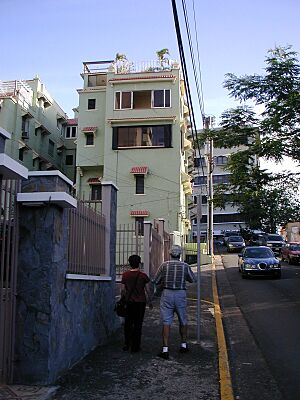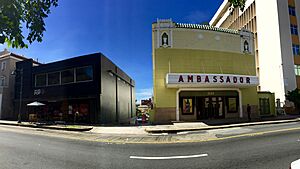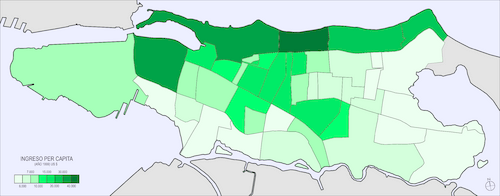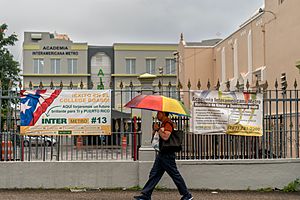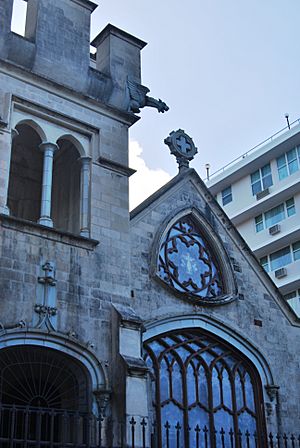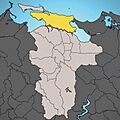Santurce, San Juan, Puerto Rico facts for kids
Quick facts for kids
Santurce
|
|
|---|---|
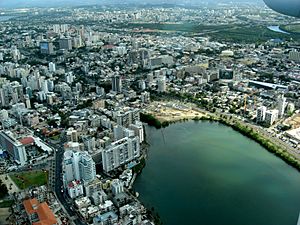
Aerial view of Santurce in 2008
|
|

Location of Santurce shown in yellow within San Juan shown in light gray
|
|
| Commonwealth | Puerto Rico |
| Municipality | San Juan |
| Area | |
| • Total | 8.70 sq mi (22.53 km2) |
| • Land | 5.24 sq mi (13.57 km2) |
| • Water | 3.46 sq mi (8.96 km2) |
| Elevation | 49 ft (15 m) |
| Population | |
| • Total | 69,469 |
| • Density | 13,257.4/sq mi (5,118.7/km2) |
| (US Census 2020) | |
| Time zone | UTC−4 (AST) |
| ZIP Codes |
00907, 00908, 00909, 00911, 00912, 00913, 00914, 00915, 00916, 00936, 00940
|
Santurce (pronounced san-TOOR-seh) is a very important part of San Juan, the capital city of Puerto Rico. Its name comes from the Basque word Santurtzi, which means Saint George. In 2020, about 69,469 people lived there. Santurce is the largest and most populated area in San Juan. It's also one of the most densely populated places on the island.
| Historical population | |||
|---|---|---|---|
| Census | Pop. | %± | |
| 1900 | 5,840 | — | |
| 1910 | 17,338 | 196.9% | |
| 1920 | 35,096 | 102.4% | |
| 1930 | 81,960 | 133.5% | |
| 1940 | 133,091 | 62.4% | |
| 1950 | 195,007 | 46.5% | |
| 1960 | 178,179 | −8.6% | |
| 1970 | 128,232 | −28.0% | |
| 1980 | 101,103 | −21.2% | |
| 1990 | 95,184 | −5.9% | |
| 2000 | 94,337 | −0.9% | |
| 2010 | 81,251 | −13.9% | |
| 2020 | 69,469 | −14.5% | |
| U.S. Decennial Census 1899 (shown as 1900) 1910–1930 1930–1950 1980–2000 2010 |
|||
Contents
Geography of Santurce
Santurce is shaped like a peninsula. This means it's a piece of land mostly surrounded by water but connected to the mainland on one side. It borders the Isla Verde area of Carolina to the east.
The peninsula is about 7.6 kilometers (4.7 miles) long. It's bounded by the Atlantic Ocean to the north. This northern coast has over five kilometers of beaches. To the east, you'll find Laguna San José and Laguna Los Corozos.
To the south, the Martín Peña Channel separates Santurce from other parts of San Juan. To the west is San Juan Bay. Three bridges connect Santurce to La Isleta, where Old San Juan is located.
Santurce covers about 22.53 square kilometers (8.70 square miles). Most of this area is land, but a good part is water. The land is mostly flat, with some small hills in the middle. There are also swampy areas near the Martín Peña Channel and San José Lagoon. The highest point in Santurce is at Monteflores, which is about 23 meters (75 feet) high.
History of Santurce
Early Beginnings
Santurce was first founded in 1760. It was called San Mateo de Cangrejos, which means "Saint Matthew of the Crabs." The area was originally settled by the native Arawak people. Later, enslaved people from Africa were brought here from nearby islands.
Over the years, Santurce grew because of its important location. It was right between San Juan and its southern areas.
Spanish Influence and a New Name
In 1876, an engineer named Pablo Ubarri came to Puerto Rico from Spain. He helped build a railroad and a tramway connecting San Juan to the town of Río Piedras. This project helped Santurce grow and develop.
Years later, the Spanish King gave Pablo Ubarri the special title of Count of Santurce. This title was named after his hometown in Spain. Because of his new title and influence, the area was renamed Santurce. The famous tourist area of Condado in Santurce also got its name from Ubarri's title. "Condado" means "county" in Spanish, which is the land a count rules.
Becoming Part of the United States
In 1898, after the Spanish–American War, Spain gave Puerto Rico to the United States in the Treaty of Paris. In 1899, the U.S. government counted the population of Santurce, finding 5,840 people.
In 1904, the United States Army set up a training base called Camp Las Casas in Santurce. This camp was important for training soldiers of the Porto Rico Regiment of Infantry, which later became the famous "65th Infantry Regiment." Different groups of soldiers served at this base. Camp Las Casas closed in 1946, and now the Residencial Las Casas stands there.
The 20th Century Changes
During the 20th century, San Juan grew a lot. It expanded beyond its old city walls to include areas like Miramar, Santurce, and Condado. Between 1937 and 1948, Santurce became one of the most lively parts of the capital.
However, by the 1970s, many parts of Santurce started to decline. Many people moved away to the suburbs. By 1980, the San Juan metropolitan area, including Santurce, had about one-third of Puerto Rico's total population.
Santurce in the 21st Century
In the early 2000s, Santurce faced some tough economic times. But around 2009, things started to get better. Many new bars, clubs, and restaurants opened. Rent prices went down, which attracted many artists to the area.
Because of this, Santurce began to experience a new wave of growth and change. Many people now call it Puerto Rico's "hipster haven." In 2018, twenty-two colorful murals were painted around Santurce. These murals show off Santurce's unique culture and history.
People and Communities
Santurce is one of the most populated areas in Puerto Rico. It includes well-known neighborhoods like Miramar, Loíza, Isla Grande, Barrio Obrero, and Condado. These places are famous for art, music, food, fashion, and hotels. They are also home to many new technology and media companies.
The 2010 U.S. Census counted 81,251 people living in Santurce. It is the most populated "barrio" (borough) in Puerto Rico. It's also one of the most densely populated areas in San Juan.
Santurce has one of the largest Jewish communities in Puerto Rico and the Caribbean. More than 1,500 people attend the two local synagogues. For a long time, Jewish people were not officially allowed to settle in Puerto Rico. However, many came secretly.
Many Jewish people arrived from France, the Netherlands, and other islands after World War II. Some are descendants of Jewish Cubans who came after the Cuban Revolution in 1959.
Santurce also has large communities of people from the Dominican Republic, Cuba, Colombia, Argentina, and China.
Population Details
"Barrios" are traditional divisions of Puerto Rico's towns. Today, they are mostly used for counting people for the U.S. Census. The most crowded parts of Santurce are near the San José Lagoon and the Martín Peña Channel. The least crowded areas are near the mangrove swamps to the south and the western part of Isla Grande. Isla Grande used to be a military base.
Cityscape and Landmarks
Santurce has many buildings that are important for their architecture and history. You can find them mainly along Avenida Juan Ponce de León, Avenida Ashford, and Avenida Fernández Juncos.
Famous Buildings and Architecture
- Central High School: A beautiful school building from 1925, designed in the Spanish Renaissance style.
- Condado Vanderbilt Hotel: A Spanish Revival style hotel built in 1919.
- La Concha Resort: A modern hotel designed by Toro Ferrer, Architects.
- Residencia Aboy-Lompré: A historic house from 1919 designed by Miguel Ferrer.
Public Spaces to Explore
- La Placita de Santurce: This is a historic marketplace. It includes the Plaza del Mercado, which is a farmers' market with local vendors. It's also a very popular place for nightlife, with many bars and restaurants.
- La Ventana al Mar (2004): A public space designed by Andrés Mignucci.
- Plaza Antonia Quiñones (also known as Stella-Maris Square and Placita del Condado; 2000): Another public square designed by Andrés Mignucci.
Beaches in Santurce
- Condado Bridge Beach
- Ocean Park
Seaport
- Port of San Juan: An important port for ships and trade.
Getting Around Santurce
Public transportation in Santurce includes several bus lines, known locally as guaguas. These buses run along the main roads like Ponce de León and Fernández Juncos.
Santurce also has a rapid transit system called Tren Urbano. The Sagrado Corazón station is the last stop on San Juan's metro line. It's located in the southeast part of Santurce.
Santurce is very close to two airports. The main airport for Puerto Rico, Luis Muñoz Marín International Airport, is just a few minutes away by car. There's also a smaller airport, Isla Grande Airport, nearby.
Culture and Arts
Santurce is a hub for art and culture in Puerto Rico.
Museums and Galleries
Santurce is home to two major museums on the island:
- the Museum of Art of Puerto Rico
- the Puerto Rico Museum of Contemporary Art
- the Galería Casa Jefferson
Performing Arts
- Ballets de San Juan: A dance company.
- Luis A. Ferré Performing Arts Center: A modern building known for its beautiful design. It hosts many plays, concerts, and shows.
Education in Santurce
Santurce has some of the best private schools and universities in Puerto Rico.
- Conservatory of Music of Puerto Rico: A place where students can study music.
- University of the Sacred Heart: A well-known university.
- Academia San Jorge
- Academia Interamericana Metro
- Perpetuo Socorro
- Robinson School
- Saint John's School
There are also important public schools:
- Padre Rufo School: A public school that teaches in two languages.
- Central High School: Built in 1925, this school is listed on the U.S. National Register of Historic Places.
Places of Worship
Santurce has many beautiful churches and synagogues:
- Episcopal Cathedral of St. John the Baptist
- Nuestra Señora de Lourdes Chapel: A Neo-Gothic style chapel built in 1909.
- Sagrado Corazon Church
- Synagogue Shaare Tzadik
- Stella-Maris Catholic Church
- Temple Beth Shalom
- Parroquia San Vicente de Paúl
Sports in Santurce
Santurce has some of the most modern swimming facilities in the Caribbean. The San Juan Natatorium is an Olympic-sized aquatic sports center. It hosts many local and international swimming events.
The district is also home to two famous sports teams, both called the Santurce Crabbers (Cangrejeros de Santurce). The name "Crabbers" comes from the original name of the area. These teams have been part of the community for over 70 years. Both the baseball and basketball teams have been very successful. The baseball team is often called the "New York Yankees of Puerto Rico" because of its many wins and legendary players like Roberto Clemente and Willie Mays.
Economy and Tourism
Santurce saw a lot of economic growth after World War II. During this time, the area became more active and prosperous. Tourism is also a very important industry in Santurce. This is because it's close to Puerto Rico's main international airport, Luis Muñoz Marín International Airport, and the smaller Fernando Luis Ribas Dominicci Airport.
Many luxurious hotels are located in the Condado area of Santurce. These include La Concha Resort, Marriott, and the Conrad Hotel.
Famous People from Santurce
Many talented people were born or lived in Santurce:
- Miguel Algarín: A writer and poet.
- Miguel Arteta: A film and television director.
- Pura Belpré: A famous author.
- Giannina Braschi: An author.
- Tego Calderón: A popular reggaeton singer.
- Deborah Carthy-Deu: Miss Puerto Rico and Miss Universe 1985.
- José Ferrer: A well-known actor, director, and producer.
- Wilfredo Gómez: A professional boxer.
- Nathan Leopold: An American murderer (briefly lived there).
- Luis López Nieves: A writer.
- Gilberto Monroig: A singer.
- Andy Montañez: A salsa singer.
- Carlos Ponce: An actor, singer, and composer.
- Jorge Posada: A baseball player for the New York Yankees.
- Ismael Rivera: A famous salsa singer.
- Gilberto Santa Rosa: A band leader and salsa singer.
- Daniel Santos: A singer and composer.
- Arturo Schomburg: A writer and historian.
- Olga Tañón: A popular singer.
Images for kids
See also
 In Spanish: Santurce (Puerto Rico) para niños
In Spanish: Santurce (Puerto Rico) para niños


